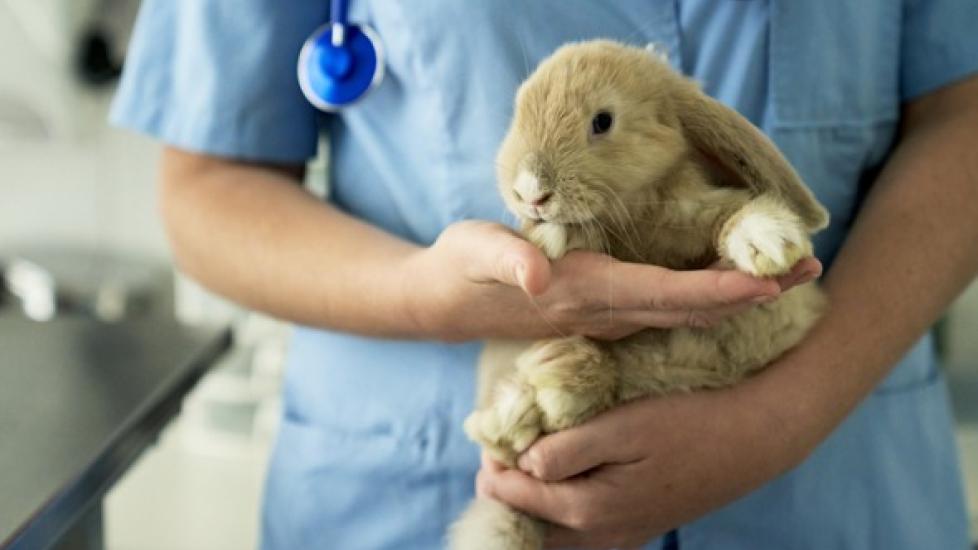Partial or Complete Loss of Muscle Control in Rabbits
Paresis and Paralysis in Rabbits
Paresis is defined as weakness of voluntary movement, or partial paralysis, while paralysis is the complete lack of voluntary movement.
Symptoms and Types
Four of the main types of motor dysfunction include:
- Quadriparesis or tetraparesis - weakness of voluntary movements in all limbs
- Quadriplegia or tetraplegia - absence of all voluntary limb movement
- Paraparesis - weakness of voluntary movements in hind limbs
- Paraplegia - absence of all voluntary movement in the hind limbs
Their symptoms may present suddenly or gradually. However, sudden onset of paresis/paralysis is common following an injury to the spine. In fact, many rabbits sustain a fracture or a dislocation of the spine just by suddenly jumping within their cages due to a startling event such as a loud thunderstorm, fireworks, or loud noise from unfamiliar people or pets in the home. Other symptoms associated with these conditions include:
- Abnormal walking pattern (unable to hop or get up; dragging of affected limbs)
- Loss of bladder control
- Loss of hair, flaking over the head, shoulders, and tail due to inability to properly groom
- Severe obesity due to lack of exercise
Recommended Products
Causes
In rabbits, weakness may be due to the effects of organ or metabolic disease, obesity, or to direct damage to the nerves. If the nerves are injured -- either within the brain or spinal column -- they will not communicate properly with each other and the rest of the body. This can lead to to increased stiffness in the muscles, and hypersensitive reflexes. If the peripheral (outer) nerves are damaged, meanwhile, absence of muscle reflexes and decreased muscle tone is seen.
Diagnosis
Your veterinarian will first need to confirm that the problem is weakness or paralysis by localizing the problem to either the lower or upper motor neuron system. Several tests will be conducted to determine the underlying cause of the motor dysfunction. A complete blood profile will be conducted, including a chemical blood profile, a complete blood count, a urinalysis, and an electrolyte panel.
Both voluntary and involuntary motor responses will be analyzed, with urinary and bladder function checked. X-ray imaging is an important diagnostic procedure for the discovery of this disorder's origins. Spinal X-rays will be taken to assess fracture or dislocation of a calcified disc, narrowed disc spaces, bony tumor, or vertebral malformation, and skull X-rays may show a dental disease, which, if chronic, can lead to weakness and chronic debility. Whole body X-rays may identify an underlying heart disease, tumors, kidney stones, or orthopedic disorders. In addition, computed tomography (CT) or magnetic resonance imaging (MRI) may be used to evaluate potential brain disease. An abdominal ultrasonography will be done if an underlying metabolic disease (e.g., renal, hepatic) is suspected.
Since partial or complete loss of muscle control is most often linked to a trauma or diseased condition of the spine or nervous system, the most effective method by which to determine the location of a spinal cord injury, tumor, or infection is to take a sample of spinal cord fluid (cerebrospinal fluid [CSF]) for analysis. Your doctor will also need to get a clear view of the spinal cord. Using a technique called a myelography, which uses an injection of a radiopaque agent into the spinal space in order to improve visibility on X-ray, he or she will be able to view any apparent abnormalities in the spine. The veterinarian may also need to take a nerve sample, or a sample from the muscle tissue, for biopsy.
Treatment
Your rabbit will be cared for as an inpatient if it presents with severe weakness or paralysis, or until bladder function can be ascertained (an indicator of the severity of the condition). If possible, the veterinarian will treat the underlying cause of the paresis or paralysis. For example, pain relieving medication as well as anesthetics and gastric protective agents may be provided. If paralysis is present, the bladder may be emptied by manual compression. Inability to urinate voluntarily can make the rabbit more susceptible to infection, so it will be important to monitor for signs of urinary infection and the spread of infection into the bladder.
For fractures and damaged nerves, your doctor may be able to surgically repair them. It must be kept in mind that some injuries are too traumatic for repair. The final outcome will be dependent on the diagnosis.
Living and Management
If your rabbit is having problems with urinary continence, you will need to make extra efforts to keep the bedding clean so that the rabbit is not in soiled bedding. Additionally, keep the fur clean and dry; check and clean your rabbit's genital and hind leg area frequently to prevent urine scalding.
You will need to restrict your rabbit's activity until spinal trauma and disk prolapse can be ruled out. If your rabbit has been placed on cage rest, you will need to make sure to move your rabbit at regular intervals in order to prevents lung congestion and pressure sore (bed sore) formation by turning it from one side to the other four to eight times daily. This is very important, as the rabbit will not be able to do this on its own. If your rabbit is unable to urinate on its own, you will need to perform manual expression of its bladder regularly enough tot prevent the possibility of bladder infection. Your veterinarian will go over the procedure with you so that you can perform this task at home.
If your rabbit is only affected in the hind legs, a cart -- the type that is made for small breed dogs -- may sometimes be fitted for larger rabbits, and may be tolerated for limited periods. Encourage oral fluid intake by offering fresh water, wetting leafy vegetables, or flavoring water with vegetable juice, and offer a large selection of fresh, moistened greens such as cilantro, romaine lettuce, parsley, carrot tops, dandelion greens, spinach, collard greens, etc., and good-quality grass hay. You should also continue to offer your rabbit it's usual pellet diet, as the initial goal is to get the rabbit to eat a full diet. If your rabbit cannot, or will not eat, you will need to syringe feed a gruel mixture. High-carbohydrate, high-fat nutritional supplements are contraindicated and should not be given with the approval of your doctor. Do not give your rabbit any foods or medicines that have not been preapproved by your veterinarian.
Featured Image: iStock.com/xavierarnau




